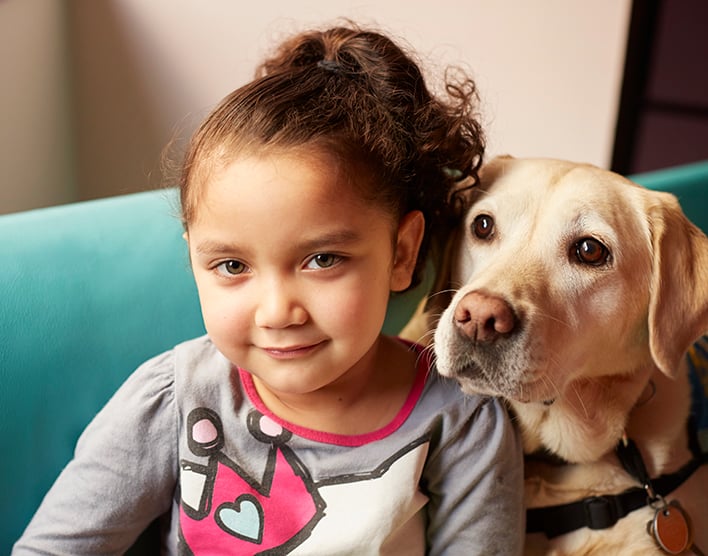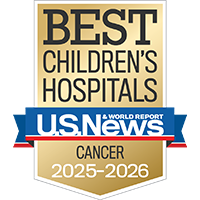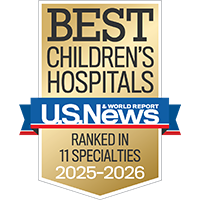Tender wagging care
Our therapy dogs spread joy and smiles at the bedside and throughout the hospital.
Visit Child Life services

Although liver cancer (also called hepatoma) is rare in children, there are several types that can affect them. The most common is hepatoblastoma. But even that is very rare: Each year, only 100 to 125 new cases of hepatoblastoma are diagnosed in North America. These cases are usually in children under the age of 3.
One of the body's largest organs, the liver has many functions. These include filtering harmful substances from the blood; producing bile, which helps digest fats from food; and storing glycogen (a form of sugar), which the body uses for energy.
Cancers arise when cells begin growing uncontrollably and become abnormal. A primary liver cancer is one that starts in the liver, even if it later spreads to other parts of the body. A cancer that began elsewhere and later spreads to the liver is called secondary liver cancer. Hepatoblastoma is a primary liver cancer.

Top 10 in the nation and best in Northern California for cancer care

Ranked among the nation's best in 11 specialties
Hepatoblastoma is a tumor that develops when genetic changes in liver cells cause them to grow and divide abnormally. Researchers aren't sure what causes the genes to change, but children born with certain genetic conditions have an increased risk of developing the disease. The conditions include:
Other risk factors for hepatoblastoma include:
While any cancer diagnosis is scary, you may feel somewhat reassured to know that hepatoblastoma treatment is typically effective. When detected and treated before it spreads, the condition has a survival rate that can reach 90%.
Less commonly, children develop other types of liver cancer, such as:
In early stages, liver cancer may not cause symptoms. Some signs that may develop are similar to those of other conditions, so it's important to have your child checked by a doctor if they experience any of the following:
A series of tests and procedures are used to diagnose childhood liver cancers, including hepatoblastoma. Initially, your child's doctor will perform a thorough physical exam. If this raises concern about a tumor in the liver, the doctor may want to run certain diagnostic tests, such as:
The main treatments for liver cancer are surgery, chemotherapy and radiation. In some cases, doctors recommend a liver transplant. Patients typically have more than one type of treatment. In designing a plan for your child, the doctor will consider several factors, including:
The goal of surgery is to remove the tumor while sparing as much of the liver as possible. If the cancer is confined to one area, a surgeon may be able to take only that part of the liver. The disease may be cured if the tumor is small and can be completely removed. This is possible more often for hepatoblastoma than for hepatocellular carcinoma.
Chemotherapy is using drugs to kill cancer cells. These substances are usually given intravenously (into a vein). Chemo may be used before surgery to shrink the tumor or after surgery to destroy any remaining cancer cells. When surgery isn't possible, chemo may be used as a stand-alone therapy.
Radiation therapy is using high-energy rays (usually X-rays) to kill cancer cells. As with chemo, this treatment may be used before surgery to shrink the tumor or after surgery to get rid of cancer cells that remain.
If the cancer has spread throughout the liver, it may be necessary to replace the liver with one from a matched donor. Liver for transplantation can come from a deceased donor or a living donor.
Patients may have opportunities to participate in clinical trials (studies evaluating promising treatments) for hepatoblastoma. Learn more about the process and potential benefits of enrolling your child in a clinical trial.
Your child's care providers will talk to you about side effects kids typically experience during treatment. Short-term issues may include pain after surgery, nausea and fatigue during chemotherapy treatment, and a rash or other types of discomfort during radiation therapy. In addition, it's important to learn about long-term effects that may develop later in life.
UCSF Benioff Children's Hospitals medical specialists have reviewed this information. It is for educational purposes only and is not intended to replace the advice of your child's doctor or other health care provider. We encourage you to discuss any questions or concerns you may have with your child's provider.

Tender wagging care
